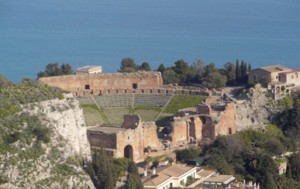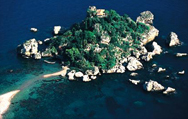Taormina was just too good a thing to remain unspoiled. Dating from the 4th century B.C., it hugs the edge of a cliff overlooking the Ionian Sea. The sea, even the railroad track, lies below, connected by bus routes. Looming in the background is Mt. Etna, an active volcano. Noted for its mild climate, Italy’s most beautiful town seems to have no other reason to exist than for the thousands on thousands of visitors who flock here for shopping and eating and enjoying the nearby beaches.
International tourism flaunts itself on the main street, Corso Umberto I, mainly April to October. After that, Taormina returns to some sense of normalcy. In spite of the hordes who descend, there’s enough charm left here to merit a visit, as Taormina still retains much of its medieval character, filled with intimate piazzas and palazzi from the 15th to the 19th century. You’ll find a restaurant for every day of the week, and countless stores sell everything from antiques to cheap souvenirs and trinkets.
You can always escape the throngs during the day seeking out adventures like climbing Mt. Etna, walking to the Castel Mola, or making a day trip to Syracuse. In summer, of course, you can hang out at the beaches below the town, though Taormina isn’t on a beach. At night you can enjoy jazz and disco or just spend some time in a local tavern or restaurant.
A lot of people contributed to putting Taormina on the map. First inhabited by a tribe known as the Siculi, it has known many conquerors, like the Greeks, Carthaginians, Romans, Saracens, French, and Spanish. Its first tourist is said to have been Goethe, who arrived in 1787 and recorded his impressions in his Journey to Italy. Other Germans followed, including a red-haired Prussian, Otto Geleng. Arriving at the age of 20 in Taormina, he recorded its beauties in his painted landscapes, which were exhibited in Paris. They caused much excitement–people had to go themselves to find out if Taormina was all that beautiful.
Another German, Wilhelm von Gloeden, arrived to photograph not only the town but also nude boys crowned with laurel wreaths. His pictures sent European high society flocking to Taormina. Von Gloeden’s photos, some of which are printed in official tourist literature to this day, form one of the most enduring legends of Taormina. Souvenir shops still sell his pictures, which, though considered scandalous in their day, are tame, even innocent, by today’s standards.
In von Gloeden’s footsteps came a host of celebs hoping to see what all the excitement was about: Truman Capote, Tennessee Williams, Marlene Dietrich, Joan Crawford, Rita Hayworth, and Greta Garbo. Always in disguise, sometimes as Harriet Brown, Garbo used Taormina as a vacation retreat from 1950 until her last mysterious arrival in 1979. Many stars, including Garbo, stayed at a villa on the road to Castel Mola owned by Gayelord Hauser, the celebrated dietitian to Hollywood stars of the golden age. In time, another wave of stars arrived, including Elizabeth Taylor and Richard Burton, Cary Grant, and the woman who turned him down, Sophia Loren.


